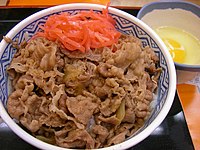Gyūdon: Difference between revisions
Undid revision 436658884 by 129.247.247.239 (talk) |
|||
| Line 22: | Line 22: | ||
{{Commonscat|gyudon}} |
{{Commonscat|gyudon}} |
||
* [http://www.yoshinoyaamerica.com Yoshinoya America] |
* [http://www.yoshinoyaamerica.com Yoshinoya America] |
||
* [http://kitchen-ninja.blog.de/2011/04/13/food-print-24-gy-363-don-10998353/ Everyday Japanese Cooking] |
|||
[[Category:Japanese cuisine]] |
[[Category:Japanese cuisine]] |
||
Revision as of 11:39, 4 July 2011
This article needs additional citations for verification. (October 2007) |

Gyūdon (牛丼), (beef bowl), is a Japanese dish consisting of a bowl of rice topped with beef and onion simmered in a mildly sweet sauce flavored with dashi (fish and seaweed stock), soy sauce and mirin (sweet rice wine). It also often includes shirataki noodles, and is sometimes topped with a raw egg. A very popular food in Japan, it is commonly served with beni shōga (pickled ginger), shichimi (ground chili pepper), and a side dish of miso soup. Gyū means "cow" or "beef", and don is short for donburi, the Japanese word for "bowl".
Fast food

Gyūdon can be found in many Japanese restaurants and some fast food chains specialize exclusively in the dish. The largest gyūdon chains in Japan are Yoshinoya and Sukiya. Another large chain, Matsuya, sells gyūdon under the name gyūmeshi (牛めし).
Beef ban
As a consequence of the fear of mad cow disease and a ban on imports of beef from the United States, Yoshinoya and most competitors were forced to terminate gyūdon sales in Japan on February 11, 2004. Yoshinoya moved its business to a similar dish made with pork instead of beef, which it named butadon (豚丼). Sukiya continued to serve gyūdon (using Australian beef) and also added a dish, tondon, equivalent to Yoshinoya's butadon, to its menu. (Buta and ton are both Japanese words for pig or pork, written with the same kanji, 豚. See tonkatsu, tonjiru.)
The Japanese Diet voted to resume beef imports from the United States in early May 2005 but the ban was reinstated in January 2006 after detectable quantities of prohibited spine tissue were found in the first post-ban shipments arriving in Japan. As the issue was discussed between the United States and Japanese governments, gyūdon vendors and customers waited for a resolution. As of September 2006, the ban has been lifted.[1]
References
- ^ As reported by MediaCorp. (Fans celebrate return of Yoshinoya beef bowl after lifting of US beef ban)
